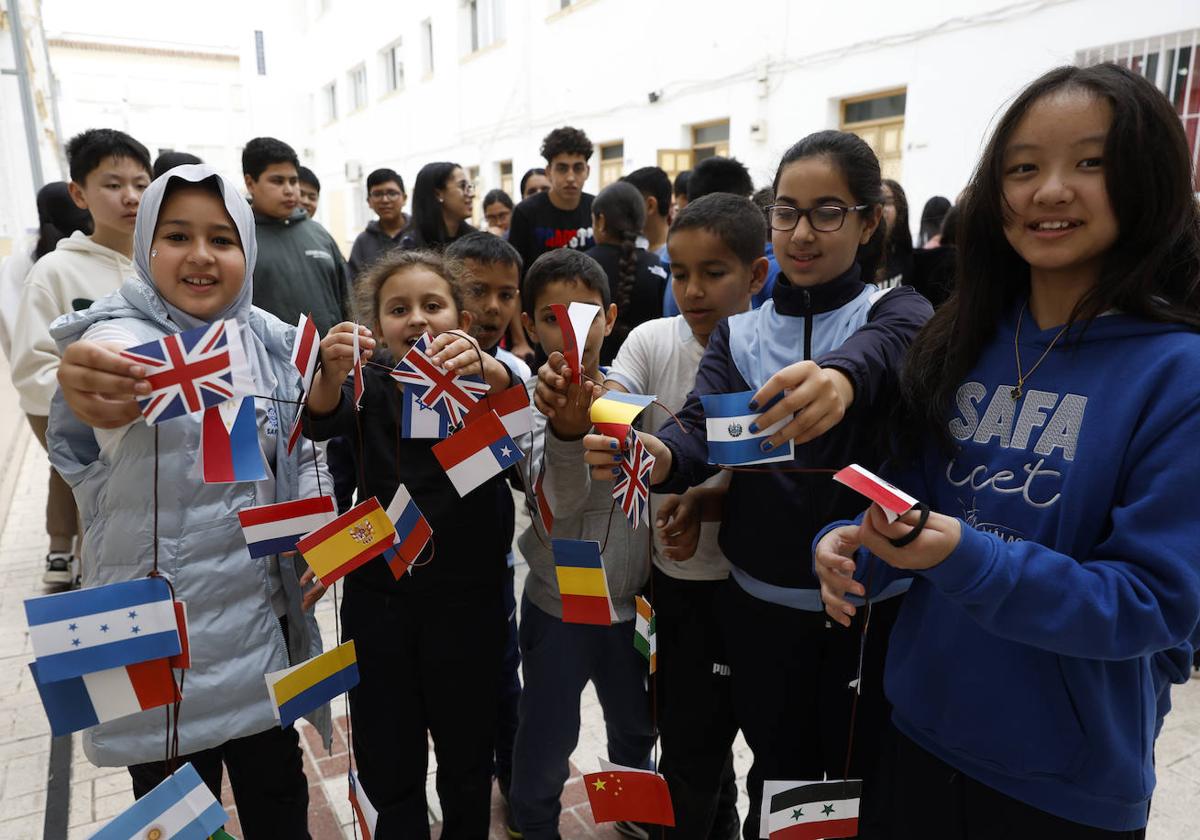A school open to the world
Multiculturalism. Pupils of 35 nationalities share desks at Safa-Icet school in El Palo, Malaga. Here they learn to live together in diversity and respect: “We don’t feel different because here everyone is”
Susana Zamora
Friday, 23 February 2024, 16:57
The shouts from the other side of the wall signal that is it break time at Sagrada Familia Safa-Icet school in the Malaga neighbourhood of El Palo.
The youngest ones snake around in a playground reserved for them while those from the primary school spread out over the one adjacent to it. Most of them are playing football. One of them is wearing a t-shirt from Morocco's national team. Inside, in a classroom, Kawthar (Morocco), Sabrina (Venezuela), Joel (Colombia) and Wenxi (China) are having fun with board games.
"Playing games is universal and has nothing to do with cultures, languages or races, which is why it's so enriching for them. It allows them to learn from one another, to understand the customs from their respective countries, to discover that other religions are followed, and to embrace that it is in that diversity that true wealth lies. Even if they have different skin colours or speak other languages, they only see a friend to have fun with," Pilar Molina, a primary school teacher, explains.
A multicultural model
She and the rest of the teaching staff are committed to an educational project that demands, as well as drives, extraordinary levels of sensitivity and empathy. This Malaga city school has been linked to the neighbourhood since its foundation in 1938, when the young Jesuit Antonio Ciganda decided to start a school to give the neighbourhood fishermen a better education. It is now a model for multicultural integration as its classrooms are shared between pupils of 35 different nationalities.

Of the 870 students enrolled this year, from all levels of education (nursery, reception, primary, secondary and vocational training), 15 per cent are foreign students, the majority from Morocco, Colombia, Venezuela, Romania, and Peru, although there are also British, French, Italian, Dutch, North American, Canadian, Armenian, Syrian, Filipino, Indian, Russian, Israeli, Senegalese, Malian, and Ukrainian students, among others.
Turning point
Pilar Casares, the school’s headteacher for the past six years, who previously worked there as a councillor, believes that the year 2003-04 was a turning point, as they began to see an increase in the number of people with other nationalities enrolling. The following year they already had 15 represented; today they have more than doubled. The reason? She does not think that there is only one; “maybe word-of-mouth,” she says. But aside from those recommendations, there are pillars that uphold the school’s identity: individual attention, teacher involvement and close relationships with families.
This is something Eva Pineda can attest to. She is from El Salvador and has her three children, 18, 13, and 6 years old enrolled in this school. She admits that she chose it because of its proximity to her house, but also because “everyone was giving me good reports.”
She only has words of gratitude for the staff, who have always made an effort so that both pupils and families feel included,” the mother points out, saying that at this school “nobody can feel different because everyone is different.”
But in Spain she did not always experience the tolerance that she is now referring to. Seventeen years ago she set out on the journey towards a better life and put her faith in Spain. She arrived in Catalonia, alone. She wanted to move forward, but had a high price to pay. She suffered discrimination and racism during the six years she worked in Barcelona. “Both are Spanish cities, but what a huge difference with people from Malaga. Now, I wouldn’t change Malaga for the world,” she explained.
Respect for others
For the headteacher, there is no secret to children of many different nationalities getting along together. According to Casares, it is “only respect for others, because although we are a Catholic school, Muslim, Hindu, or Protestant students are welcome here. This diversity allows us to teach values and to welcome families who arrive in Spain searching for a better life.” On many occasions, the “backpacks of life” that these students and their families carry are too heavy. “Sometimes parents send them here with their grandparents to give them better wellbeing or they come fleeing from wars, such as those from Ukraine or Syria. Many continue to wake up from remembering the sound of bombs,” she says.
In this small Tower of Babel, everyone is welcome and they are proud to normalise the integration of such different students. “If conflicts arise, it’s because we’re people, and not because of our place of origin, and when something does happen we try to resolve it with dialogue, respect, and acceptance of one another,” she adds.
Language barrier
She recognises, however, that the main barrier that many of these students come across is the language. “Even so, teachers make an effort with targeted programmes and personal attention so that the pupil doesn’t stay behind. Moreover, they find their greatest support from the classmates with whom they share nationality and who already speak Spanish,” she explains.
As for learning outcomes, Pilar highlights the importance of working with each pupil’s abilities so that they can achieve their full potential, but she also acknowledges a reality: pupils at a good level and who attain excellent results could end up going to university but may also opt to do professional training beforehand to help their families.
Vocational training
Gialfranco, from Peru, is in this situation. At 23 years old, he has a six-year-old son for whom he has to provide. Having been in Spain for the past five years, he is currently doing professional training to become an electrician and his son goes to the school. Gialfranco is convinced that he made the right decision in choosing this path for him: “Studying and playing together daily with children of other nationalities normalises what in my country is something extraordinary, since there is usually one foreigner in a class of mostly national students.
Balancing work and studies
On the other hand, Jorge, from Ecuador, has returned to the classroom at the age of 43. He has been in Spain for two decades and is now doing his professional training in thermal and fluid installations. He admits the difficulty in balancing classes with his work at an industrial cooling company in the Guadalhorce area.
“But since I arrived I’ve only received help to be able to manage both things and I’ve felt really at home,” he says. “From these studies, I’m not only taking the training with me, but the whole life experience, which has allowed me to get to know and understand ways of life that, if I hadn’t studied here, maybe I would have never known,” this mature student concludes.

An exhibition of multicultural school life
The Safa-Icet School in Malaga has held an exhibition at the local cultural centre in El Palo.
Entitled Miradas, it was a collection of 43 photographs by past and present pupils which demonstrated the intercultural reality of the 35 nationalities.
All the photographs were accompanied by general information about each country (capital, language, currency, religion and population) and a QR code linked to a video showing the cultural richness of each one.
The exhibition also included a world map showing the countries of origin and additional information on the kilometres separating each country from Spain.
The exhibition included suitcases, in the form of a letterbox and invited an answer to the question: What would be the first thing you would put in your suitcase?



